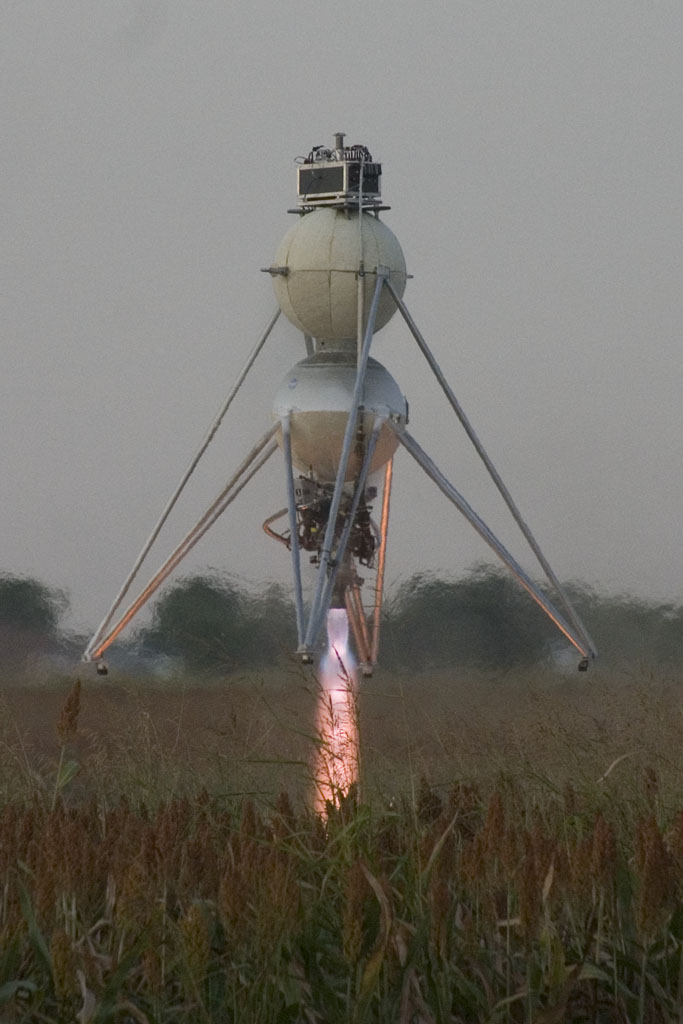





Mock lunar landers set to compete for $1 million prize
Written for newscientist.com about the first decent new space competition; the Northrop Grumman Lunar Lander Challenge of 2009. Subedited in house by Newscientist.com

Armadillos, Xombies and unreasonable blue balls
Over the coming weeks, three teams will try to complete the second and
final stage of the Lunar
Lander Challenge (LLC), sponsored by NASA and aerospace
company Northrop Grumman. Last October, Armadillo Aerospace of Texas won level one of the challenge
and $350,000 by building a rocket that made two 90-second flights, reaching an altitude of 50 metres, between flat concrete pads 100 metres apart. On Saturday, they will be aiming for the million-dollar prize for the more challenging level two.
The aim this time is to complete two flights, each lasting 3 minutes. If it can stay aloft in Earth's gravity for that long, the vehicle would have enough power to take off from the surface of the moon and go into lunar orbit.
The vehicle also has to land on a rough landscape, akin to a lunar landing site. Armadillo created their mock moonscapes at Caddo Mills airfield in Texas, using rocks and gravel.
Super Mod
Armadillo's vehicle, the Super Mod,
is propelled by a rocket engine burning a blend of liquid oxygen and alcohol. Like the Apollo landers, it is steered by changing the angle of the main engine. The Super Mod is the largest of the vehicles in the contest and,
if flown at full power, should be able to reach an altitude of 100 kilometres sometimes considered the edge of space. The technology is modular, so several Super Mods could be bolted together to make a more powerful vehicle.
According to Armadillo's John Carmack, six of them put together could complete the lunar lander challenge with a pilot on board.
Xombie
Before the end of October, Masten Space Systems and
Unreasonable Rocket , both based in California, will also be vying to win level two. Masten are following a similar approach with their XA 0.1B, nicknamed Xombie, which uses the same fuel and method of steering
(see image).
The Xombie is a technology demonstrator for larger vehicles that Masten hopes to start flying next year, with the long-term goal of providing cheap
suborbital launch services for scientific missions and space tourists.
Blue Ball
Unreasonable Rocket is a much smaller team, consisting of father and son Paul T Breed and Paul A Breed. Their vehicle, the Blue Ball,
is powered by hydrogen peroxide, which produces thrust as it decomposes to steam and oxygen when passed through a silver mesh
(see image).
With just a single propellant, the rocket needs only one tank and control valve, much simpler than dealing with two liquids that burn together. It can also be stopped and started easily and is very reliable, but on
the downside, the performance of hydrogen peroxide is only about 60 per cent of what can be achieved with two liquids. While the Blue Ball is just over 1.5 metres high much smaller than its competitors and
therefore further from a human-scale lander it could form the basis of lunar probes.
NASA's sponsorship of the prize is not directly connected to their plans, still uncertain
, for a return to the moon. "The LLC was never intended to develop technologies for actual lunar landing," Carmack told New Scientist. Instead, the hope is that it will encourage the development of
new space-technology firms
